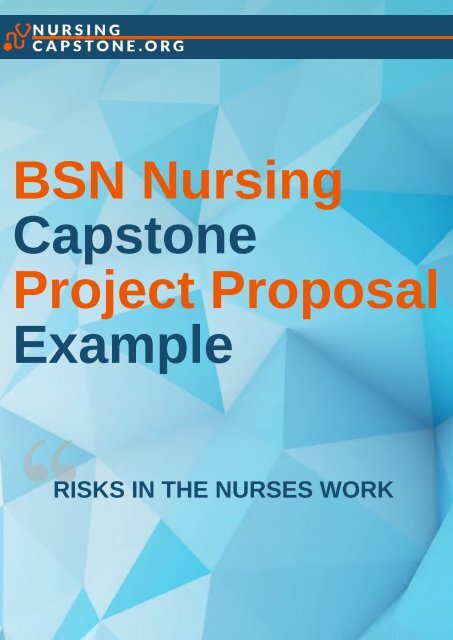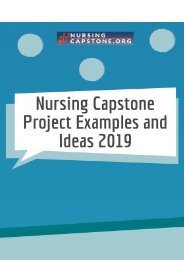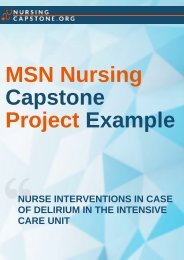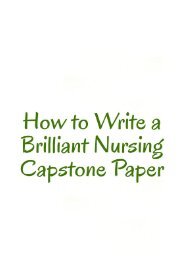BSN Nursing Capstone Project Proposal Example
Hi, we have just finished our BSN nursing capstone project proposal example. For more information https://www.nursingcapstone.org/proficient-assistance-writing-bsn-nursing-capstone-project/
Hi, we have just finished our BSN nursing capstone project proposal example. For more information https://www.nursingcapstone.org/proficient-assistance-writing-bsn-nursing-capstone-project/
Create successful ePaper yourself
Turn your PDF publications into a flip-book with our unique Google optimized e-Paper software.
<strong>BSN</strong> <strong>Nursing</strong><br />
<strong>Capstone</strong><br />
<strong>Project</strong> <strong>Proposal</strong><br />
<strong>Example</strong><br />
RISKS IN THE NURSES WORK
RISKS IN THE NURSES WORK<br />
The activity of nurses is very complex and comprehensive within the health<br />
care system and as such is faced with various risks and their associated health<br />
consequences. At a global level, nurses make up the majority of healthcare<br />
workers with the highest share of direct customer care. Healthcare is a high-risk<br />
activity, with a rate of 14.16% per 100000 inhabitants in the fourth place by the<br />
number of injuries at work and occupational diseases. The European Union is<br />
currently facing a shortage of health and social care workers, so efforts to<br />
tackle work-related health problems, job absences and early retirement become<br />
a priority in this sector. According to research by the American Nurses<br />
Association (ANA), nurses use 30% more sickness leave than other health care<br />
professionals, suggesting frequent exposure to undesired dangers, stress,<br />
harmful substances, and excessive physical effort (American nurses<br />
association, 2017). Workers' ability to work and a safe working environment are<br />
key conditions for providing quality health care. While individuals are the most<br />
responsible for their health, the role of the community is significant, while<br />
legislation and governing structures should provide conditions for safe work.<br />
Risk assessment is one of the most important factors of improving healthcare<br />
performance and the employer's obligation to assess the risk and to implement<br />
the protection measures. Safety and health protection at work must be ensured<br />
by taking into account all existing work-related circumstances, not only<br />
preventing accidents, removing hazardous substances and factors, safety of<br />
technical equipment and processes, but also situations that lead to excessive<br />
physical, mental and sensory stress or tension. This leads to the phenomena<br />
that is called ‘burnout’ (Potter, 2006).<br />
It is also necessary to bear in mind the human factor, the psychosocial aspects,<br />
the stress and the violence at the workplace. Anything that is undesirable at the<br />
workplace should be considered a risk. In addition to safety and health, the<br />
protection of employees must also focus on their satisfaction and social<br />
security. The purpose of this paper is to point out the dangers and<br />
consequences that nurses are
encountering in their activities, as well as interventions in preventing and<br />
preventing unwanted events. The aim of the paper is to present the most<br />
common possible risks in the work of nurses / technicians, as well as the ways<br />
and possibilities of prevention in order to help inform and educate them in<br />
avoiding hazards and unwanted consequences. Tasks of the work: - research<br />
and description of protection of health and safety in the work of nurses /<br />
technicians - proposal of measures and interventions in the prevention of risks<br />
in the work of nurses / technicians. Occupational safety is a set of activities and<br />
measures that ensure working conditions without any danger to life and health.<br />
The general principles of occupational safety consider the substitution of<br />
hazardous procedures in a non-hazardous manner, and where the danger<br />
remains, the necessity of the employee must be removed from the danger<br />
range (Eriksen, Tambs & Knardahl, 2006). If this rule cannot be applied, the<br />
rule of "overcoming / enclosing" the danger or harmfulness (ventilation,<br />
encapsulation, isolation, use of protective devices) is applied. In case we<br />
cannot apply any of the above principles, personal protective equipment and<br />
equipment should be applied, the employee should be selected according to<br />
the required special conditions (health and physical properties, age, etc.) and<br />
act in accordance with the rules of work in a safe manner. The employer is<br />
responsible for the safety and health of the workplace. He must provide a<br />
healthy workplace and must make a risk assessment. According to the<br />
International Labor Organization (ILO) Convention on Occupational Health<br />
Services, the occupational medicine service has the obligation to identify and<br />
assess the risk of health hazards at the workplace. At risky jobs, the health of<br />
employees must be constantly monitored in view of the greater risk of the<br />
occurrence of work-related illnesses (including occupational diseases) and<br />
injuries to work. At the same time, in accordance with international regulations<br />
and European guidelines, a rulebook determining the manner of protection of<br />
health and health surveillance of persons exposed to certain damages (ionizing<br />
and non-ionizing radiation, chemical and biological harmfulness, mutagenic and<br />
carcinogenic factors, physical hazards are being prepared or are being<br />
prepared). Education on the practical application of preventive measures<br />
includes health education and counseling on the prevention of injuries and the
most common work-related illnesses (vaccination of health workers, safe<br />
handling of cytostatic, handling of sharp objects, procedures during a stinging<br />
incident, and lifting and relocation of patients). Once a year, occupational<br />
medicine specialists conduct education on the acute effects of workplace<br />
injuries and procedures in emergency situations (first aid and emergency<br />
intervention). Working conditions are evaluated by regular job visits, and<br />
mandatory in changing work processes and operating conditions, introducing<br />
new technologies, in work processes disorders, in the event of injuries at work<br />
and occupational illnesses, as well as in the growth of obesity.<br />
Recommendations are given for the correction and adaptation of working<br />
conditions to the abilities and capabilities of employees and checking the<br />
implementation of prescribed occupational safety measures for jobs where<br />
workers are exposed to hazards, hazards and efforts that endanger health.<br />
Occupation of the workplace at the individual level is carried out in the event of<br />
occupational injuries and occupational diseases with the aim of assessing<br />
temporary incapacity, individual counseling of persons employed in health care<br />
activities with established health defects. Specific care to improve the health of<br />
employees in health care activities is aimed at reducing workplace risk,<br />
abnormalities, mortality and disability from illnesses, injuries and conditions that<br />
can be preventative. In order to carry out safety measures at work, it is<br />
necessary to provide and use personal protective equipment to prevent<br />
occupational exposure to infections associated with health protection.<br />
Protective clothing must meet certain standards, and the responsibility for the<br />
application should be measured at health facilities. The health care authorities<br />
are the ones who must provide personal protective equipment to the employees<br />
and education. Nurses must be aware of the professional risk in their work and<br />
properly and consistently use the protection measures. Health institutions must<br />
have protocols to deal with incident situations. Appropriate application of<br />
occupational safety measures preserves the health of nurses and prevents the<br />
emergence of hospital infections. Health institutions are required to make risk<br />
assessments for all tasks in order to determine the risks and measures to<br />
remove or reduce the risk. Estimates can be used to address risk-based jobs
and those to which specific occupational safety measures apply. The technical<br />
protection and the mechanization of work avoids physical burnout workers with<br />
more physical work (Ando, Ono, & Shimaoka M. et al., 2000). Apart from the<br />
physiological working conditions, working time is also a significant factor<br />
affecting work ability and health. Because of the inadequate rest of the worker,<br />
the tiredness that arises is not only manifested in maladjustment but also in the<br />
functioning of the central nervous system and senses. This way of working<br />
achieves a worse work performance, the body is exhausted and the chances of<br />
chronic illness and consequently the reduction of working life are greater. The<br />
spindle has a number of functions, such as running body and limb, supporting<br />
the body and head, which means that it must be in the correct position when<br />
transporting cargo manually. In manual freight transport, professional transport<br />
workers with specific education and experience should be distinguished from<br />
those workers for whom this is not the primary job.<br />
REFERENCES<br />
American nurses association (2017) Executive summary - American Nurses<br />
Association - Health Risk Appraisal. Maryland: American Nurses Association.<br />
Potter, C. (2006) To what extent do nurses and physicians working within the<br />
emergency department experience burnout? A review of the literature.<br />
Australasian Emergency <strong>Nursing</strong> Journal 9, 2, 57 – 64.<br />
Ando, S., Ono, Y., Shimaoka, M., et al. (2000). Associations of self-estimated<br />
workloads with musculoskeletal symptoms among hospital nurses. Occup.<br />
Environ Med., 57, 211 - 6.<br />
Eriksen, W., Tambs, K., Knardahl, S. (2006) Work factors and psychological<br />
distress in nurses’ aides: a prospective cohort study. BMC Public Health, 6,<br />
290.










